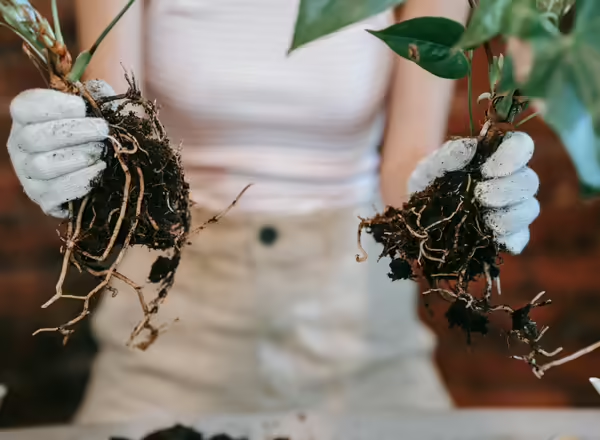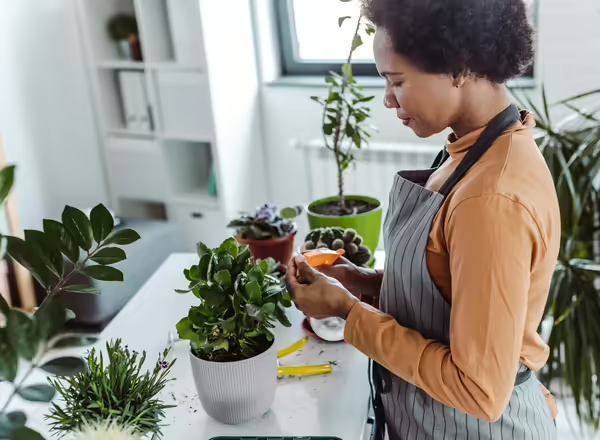Many people have discovered how easy it can be to propagate new houseplants.
In nature, plants propagate themselves in two ways – sexually (by seed) and vegetatively (using a part of the original plant, such as an offset or plantlet). Since most houseplants are herbaceous perennials, shrubs or trees, raising them from seed is not practical. It takes too long and the offspring may not have the same characteristics as the parent plant.

Vegetative propagation results in a new plant that is genetically identical to the parent plant (a clone). This is possible because many plants can regenerate missing parts. However, not all plants have equal abilities. Some plants will produce roots from a leaf cutting, but fail to produce new stems and leaves.
Plants can be reproduced by cuttings, division, layering, and by using specialized plant structures such as runners and offsets. Many plants can be propagated by more than one of these methods.
Supplies
Nearly any container can be used for propagating plants as long as it is clean and free of disease. A clear, one-gallon food storage bag works well, too.
Use sharp cutting tools such as a pocket-knife, razor blade or clippers. They should be sterilized before and between each cut by dipping in denatured alcohol.
A suitable rooting media will provide support and enough water and oxygen to the root zone. It is very important to begin with clean, disease-free media. Coarse sand, peat moss, perlite vermiculite or a combination of these materials works well.
Although some plants such as ivy and philodendron will root easily in water, we do not recommend doing this. Roots that develop in water are often weak and do not adapt as easily to potting mix as those that were formed in rooting media.
Rooting hormones are available from garden supply stores. These are chemical substances that increase the rooting percentage of many plants. A rooting hormone tends to shorten the time needed for rooting and often increases the quality and quantity of roots that form. Many houseplants root so easily on their own that rooting hormones are not important. For more difficult-to-root species, rooting hormones would be helpful. The powdered form is good because it is diluted with talc and ready for use. Follow the directions on the package.
Enclosing the propagation container in plastic, clear glass or using intermittent misting will help to increase the surrounding humidity.

- Start with healthy plants.
- Use clean and sharp cutting tools.
- Use disease-free rooting media that provides the proper water holding capacity and air spaces.
- Place in bright, indirect light.
- Increase surrounding humidity.
- Do not allow leaves to touch each other.
- Keep rooting media evenly moist, but not soggy wet.
- If cuttings are enclosed, ventilate as needed.
- Keep rooting media warm (75-80°F).
- Lower air temperatures help keep humidity high.
- Don't wait too long to transplant into individual pots.
Key to which procedure to use
- A – stem
- B – leaf cuttings
- C – leaf-bud cuttings
- D – division
- E – specialized structures
- F – air layering
Common Name, Genus and Species, Type of Propagation to Use
- African Violet, Saintpaulia spp.: A,B,D
- Aloe, Medicine Plant, Aloe spp.: D
- Aluminum Plant, Artillery Plant, Pilea spp.: A
- Anthurium Lily, Anthurium andraeanum album: A,D
- Aralia, Polyscias spp.: A
- Ardissia, Ardisia crispa: A
- Arrowhead, Nephytis Syngonium spp.: A,D
- Asparagus Fern, Asparagus sprengeri: D
- Baby Tears, Helxine soleirolii: A
- Boston Fern, Nephrolepis exaltata: A,D,E
- Bromeliads, Vase Plant Earth Star, Bromeliads: D,E
- Cactus, Cacti: A
- Cast Iron Plant, Aspidistra elatior: D
- Chinese Evergreen, Aglaonema spp.: A,D
- Christmas Cactus, Schlumbergera: A
- Coleus, Colleus blumei: A
- Croton, Codiaeum Variegatum: A
- Clover Plant, Oxalis spp.: D
- Crown of Thorns, Poinsettia, Pencil Tree, Euphorbia spp.: A
- Devils Ivy, Pothos, Scindapsus spp.: A,C
- Dracaena, Dragon Tree, Corn Plant, Ribbon Plant, Dracaena spp.: A,F
- Dumbcane, Dieffenbachia spp.: A,F
- English Ivy, Hedera spp.: A,C
- False Aralia, Dizygotheca elegantissima: A,F
- Flame Violet, Episica spp.: A,B
- Flowering Maple, Abutilon x hybridum: A
- Gardenia, Gardenia jasminoides: A
- Geranium, Pelargonium spp.: A
- Goldfish Plant, Columnea spp.: A
- Grape Ivy, Cissus rhombifolia: A,C
- Jade Plant, Crassula argentea: A,B,C
- Kalanchoe, Kalachoe spp.: A,D
- Lipstick Vine, Aeschynanthus javanicus: A
- Orchid, Orchid: A,D
- Orchid Cactus, Epiphyllum spp.: B
- Peach Lily, White Flag, Spathiphyllum spp.: D
- Prayer Plant, Maranta spp.: D,E
- Piggy-back Plant, Tolmiea menziesii: B,E
- Philodendron, Philodendron spp.: A,F
- Rex Begonia, Begonia (rhizomatus): A,B,D
- Rubber Plant, Ficus elastica: A,F
- Schefflera, Brassica spp.: A,C,F
- Screwpine, Pandanus veitchii: A,D
- Sedum, Sedum spp.: A,B,C
- Serrisa, Serrisa Foetida: A
- Snake Plant, Sansevieria spp.: B,D
- Spider Plant, Chlorophytum spp.: D,E
- Split leaf Philodendron, Monstera deliciosa: A
- Staghorn Fern, Platycerium spp.: D,E
- Strawberry Begonia, Saxifraga sarmentosa: E
- Swedish Ivy, Plectranthus australis: A,C
- Table Fern, Pteris spp.: D
- Three-Men-In-A-Boat, Rhoeo spp.: A,D
- Tuberous Begonia, Begonia (tuberous): A,E
- Velvet Plant, Gynura aurantica: A,C
- Waffle Plant, Hemigraphis colorata: A
- Wandering Jew, Inch Plant, Tradescantia spp.: A
- Wandering Jew, Inch Plant, Zebrina spp.: A
- Wax Begonia, Begonia (Filxous): A,C
- Wax Plant, Hoya carnosa: A,C
- Weeping Fig, Ficus benjamina: A
- Zebra Plant, Aphelandra squarrosa: A,F